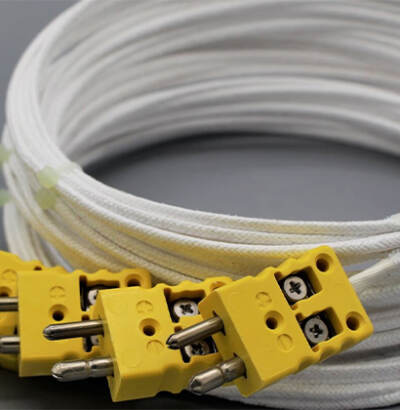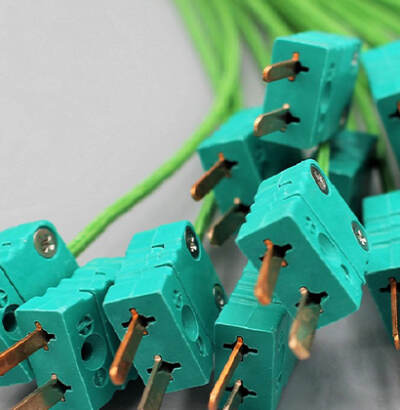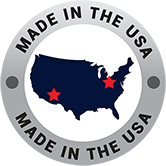What Is K Type Thermocouple? Complete Guide to Testing and Calibration
K type thermocouples are the most widely used temperature sensors in industrial applications, trusted for their versatility, durability, and cost-effectiveness. At Cleveland Electric Laboratories, we’ve been manufacturing precision K type thermocouples for over 100 years, providing critical temperature measurement solutions across aerospace, power generation, and industrial manufacturing.
Understanding what makes K type thermocouples the industry standard—and how to properly test and calibrate them—is essential for maintaining accurate temperature control in demanding industrial environments.
What Is K Type Thermocouple?
A K type thermocouple is a temperature-sensing device consisting of two dissimilar metal alloys: Chromel (nickel-chromium) and Alumel (nickel-aluminum-silicon). These materials are joined at one end to form a measuring junction that generates a voltage proportional to temperature changes through the Seebeck effect.
Key Characteristics of K Type Thermocouples
- Wire Color Coding: Red (+) and yellow (-) wires for easy field identification
- Temperature Range: -270°C to 1,260°C (-454°F to 2,300°F)
- Standard Accuracy: ±2.5°C (±4.5°F) or ±0.75% of reading Special Limits of Error: ±1.1°C (±2°F) or ±0.4% of reading
Why K Type Is Industry Standard
K type thermocouples dominate industrial applications due to several critical advantages:
- Widest temperature range among common thermocouple types
- Excellent oxidation resistance up to 1,000°C in air
- Good corrosion resistance in most industrial environments
- Cost-effective solution for high-temperature measurement
- Fast response time for dynamic temperature monitoring
- Universal compatibility with industrial control systems


Industrial Applications of K Type Thermocouples
K type sensors monitor combustion temperatures, exhaust gas temperatures, and turbine blade conditions in jet engines and industrial gas turbines. Their high-temperature capability and oxidation resistance make them essential for engine performance optimization and safety monitoring.
Steel and Metal Processing
In steel mills, forging operations, and heat treating furnaces, K type thermocouples provide reliable temperature measurement for annealing, hardening, and tempering processes. They withstand the harsh conditions of molten metal environments and rapid thermal cycling.
Boiler monitoring, steam temperature measurement, and combustion control in power plants rely on K type thermocouples for efficiency optimization and emissions control. Their stability at elevated temperatures ensures accurate long-term performance.
Chemical and Petrochemical
Process heating, reactor temperature monitoring, and catalyst bed temperature control use K type sensors for their chemical resistance and high-temperature stability in corrosive environments.
How to Test a Type K Thermocouple
Proper testing ensures your K type thermocouple provides accurate, reliable temperature measurement. Regular testing prevents costly process failures and maintains product quality.
Visual Inspection Method
Step 1: Examine the thermocouple sheath for cracks, corrosion, or physical damage
Step 2: Check wire insulation for deterioration, especially near high-temperature zones
Step 3: Inspect junction for oxidation, contamination, or mechanical damage
Step 4: Verify proper wire color coding (red positive, yellow negative)
Electrical Continuity Testing
Equipment Needed: Digital multimeter with millivolt capability
Step 1: Set multimeter to resistance (ohms) mode
Step 2: Measure resistance between thermocouple wires (should read low resistance, typically <25 ohms) Step 3: Test insulation resistance between each wire and sheath (should read >10 megohms)
Step 4: Check for short circuits between positive and negative wires
Ice Bath Verification Test
Equipment Needed: Ice bath at 0°C, digital thermometer, multimeter
Step 1: Create ice bath with distilled water and clean ice
Step 2: Insert thermocouple junction into ice bath
Step 3: Measure millivolt output (should read approximately 0 mV at 0°C)
Step 4: Compare reading to NIST reference tables for accuracy verification
Comparative Testing Method
Step 1: Place test thermocouple alongside a calibrated reference sensor
Step 2: Heat both sensors to known temperature (100°C boiling water works well)
Step 3: Compare readings between test and reference thermocouples
Step 4: Calculate deviation and determine if within acceptable tolerance
How to Calibrate K Type Thermocouple
Thermocouple calibration ensures your K type thermocouple maintains accuracy over its operational life. Cleveland Electric Laboratories provides NIST-traceable calibration services for critical applications.
When Calibration Is Required
- New installations requiring documented accuracy
- Annual maintenance programs for quality systems
- After exposure to extreme temperatures or contamination
- Process critical applications requiring verified accuracy
- Regulatory compliance (FDA, ISO, aerospace standards)
Calibration Equipment Required
Calibration Furnace: Stable, uniform temperature source Reference Standard: NIST-traceable platinum resistance thermometer (PRT) Data Acquisition: Precision measurement system Ice Bath: 0°C reference point for cold junction compensation.
Step-by-Step Calibration Process
Step 1: Preparation
- Clean thermocouple junction and sheath
- Verify electrical continuity and insulation resistance
- Document serial numbers and previous calibration data
Step 2: Reference Points
- Establish ice point (0°C) for cold junction reference
- Select calibration temperatures across operating range
- Typical points: 0°C, 100°C, 500°C, 1000°C
Step 3: Calibration Procedure
- Insert thermocouple and reference standard into calibration furnace
- Allow temperature to stabilize (typically 10-15 minutes)
- Record thermocouple output and reference temperature simultaneously
- Repeat for each calibration point
Step 4: Data Analysis
- Calculate deviation at each temperature point
- Determine if thermocouple meets accuracy specifications
- Generate calibration certificate with correction factors if needed
Calibration Standards and Tolerances
| Temperature Range | Standard Tolerance | Special Limits |
|---|---|---|
| 0°C to 375°C | ±1.5°C or ±0.4% | ±1.1°C or ±0.4% |
| 375°C to 1000°C | ±0.75% | ±0.4% |
Above 1000°C: Contact CEL for specialized calibration
K Type Thermocouple Selection Considerations
Junction Types and Applications
Grounded Junction: Fast response, ideal for dynamic processes, susceptible to electrical noise Ungrounded Junction: Electrical isolation, noise immunity, preferred for PLC systems Exposed Junction: Fastest response, fragile, suitable for clean gas streams
Sheath Materials
Stainless Steel: General purpose, moderate corrosion resistance Inconel: High-temperature oxidation resistance, combustion applications Ceramic: Extreme temperature capability, chemically aggressive environments
Common Performance Issues
Drift at High Temperatures: Chromium migration can cause reading drift above 1000°C Green Rot: Preferential oxidation in certain atmospheric conditions Decalibration: Gradual accuracy loss from contamination or thermal cycling
Troubleshooting K Type Thermocouple Problems
Symptom: Erratic or Noisy Readings
Causes: Electrical interference, poor connections, damaged insulation Solutions: Use ungrounded junction, improve shielding, check wire integrity
Symptom: Gradual Reading Drift
Causes: High-temperature exposure, contamination, aging Solutions: Recalibration, replacement, improved protection
Symptom: No Signal Output
Causes: Open circuit, broken wires, failed junction Solutions: Continuity testing, visual inspection, replacement



